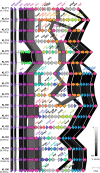Kaptive 2.0: updated capsule and lipopolysaccharide locus typing for the Klebsiella pneumoniae species complex
- PMID: 35311639
- PMCID: PMC9176290
- DOI: 10.1099/mgen.0.000800
Kaptive 2.0: updated capsule and lipopolysaccharide locus typing for the Klebsiella pneumoniae species complex
Abstract
The outer polysaccharide capsule and lipopolysaccharide (LPS) antigens are key targets for novel control strategies targeting Klebsiella pneumoniae and related taxa from the K. pneumoniae species complex (KpSC), including vaccines, phage and monoclonal antibody therapies. Given the importance and growing interest in these highly diverse surface antigens, we had previously developed Kaptive, a tool for rapidly identifying and typing capsule (K) and outer LPS (O) loci from whole genome sequence data. Here, we report two significant updates, now freely available in Kaptive 2.0 (https://github.com/katholt/kaptive): (i) the addition of 16 novel K locus sequences to the K locus reference database following an extensive search of >17 000 KpSC genomes; and (ii) enhanced O locus typing to enable prediction of the clinically relevant O2 antigen (sub)types, for which the genetic determinants have been recently described. We applied Kaptive 2.0 to a curated dataset of >12 000 public KpSC genomes to explore for the first time, to the best of our knowledge, the distribution of predicted O (sub)types across species, sampling niches and clones, which highlighted key differences in the distributions that warrant further investigation. As the uptake of genomic surveillance approaches continues to expand globally, the application of Kaptive 2.0 will generate novel insights essential for the design of effective KpSC control strategies.
Keywords: K locus; Klebsiella capsule K-locus genomic surveillance; Klebsiella pneumoniae; O locus.
Conflict of interest statement
The authors declare that there are no conflicts of interest.
Figures





Similar articles
-
Kaptive Web: User-Friendly Capsule and Lipopolysaccharide Serotype Prediction for Klebsiella Genomes.J Clin Microbiol. 2018 May 25;56(6):e00197-18. doi: 10.1128/JCM.00197-18. Print 2018 Jun. J Clin Microbiol. 2018. PMID: 29618504 Free PMC article.
-
Identification of Klebsiella capsule synthesis loci from whole genome data.Microb Genom. 2016 Dec 12;2(12):e000102. doi: 10.1099/mgen.0.000102. eCollection 2016 Dec. Microb Genom. 2016. PMID: 28348840 Free PMC article.
-
Identification of Acinetobacter baumannii loci for capsular polysaccharide (KL) and lipooligosaccharide outer core (OCL) synthesis in genome assemblies using curated reference databases compatible with Kaptive.Microb Genom. 2020 Mar;6(3):e000339. doi: 10.1099/mgen.0.000339. Microb Genom. 2020. PMID: 32118530 Free PMC article.
-
The Impact of Insertion Sequences on O-Serotype Phenotype and Its O-Locus-Based Prediction in Klebsiella pneumoniae O2 and O1.Int J Mol Sci. 2020 Sep 8;21(18):6572. doi: 10.3390/ijms21186572. Int J Mol Sci. 2020. PMID: 32911792 Free PMC article.
-
Klebsiella pneumoniae Lipopolysaccharide as a Vaccine Target and the Role of Antibodies in Protection from Disease.Vaccines (Basel). 2024 Oct 17;12(10):1177. doi: 10.3390/vaccines12101177. Vaccines (Basel). 2024. PMID: 39460343 Free PMC article. Review.
Cited by
-
Geographical distribution, disease association and diversity of Klebsiella pneumoniae K/L and O antigens in India: roadmap for vaccine development.Microb Genom. 2024 Jul;10(7):001271. doi: 10.1099/mgen.0.001271. Microb Genom. 2024. PMID: 39037209 Free PMC article.
-
Phylogenetic lineages and antimicrobial resistance determinants of clinical Klebsiella oxytoca spanning local to global scales.Microbiol Spectr. 2023 Sep 7;11(5):e0054923. doi: 10.1128/spectrum.00549-23. Online ahead of print. Microbiol Spectr. 2023. PMID: 37676032 Free PMC article.
-
Structural biology and functional features of phage-derived depolymerase Depo32 on Klebsiella pneumoniae with K2 serotype capsular polysaccharides.Microbiol Spectr. 2023 Sep 26;11(5):e0530422. doi: 10.1128/spectrum.05304-22. Online ahead of print. Microbiol Spectr. 2023. PMID: 37750730 Free PMC article.
-
Widespread Detection of Yersiniabactin Gene Cluster and Its Encoding Integrative Conjugative Elements (ICEKp) among Nonoutbreak OXA-48-Producing Klebsiella pneumoniae Clinical Isolates from Spain and the Netherlands.Microbiol Spectr. 2023 Aug 17;11(4):e0471622. doi: 10.1128/spectrum.04716-22. Epub 2023 Jun 13. Microbiol Spectr. 2023. PMID: 37310221 Free PMC article.
-
Rapid design of bacteriophage cocktails to suppress the burden and virulence of gut-resident carbapenem-resistant Klebsiella pneumoniae.Cell Host Microbe. 2024 Nov 13;32(11):1988-2003.e8. doi: 10.1016/j.chom.2024.09.004. Epub 2024 Oct 4. Cell Host Microbe. 2024. PMID: 39368473
References
-
- Cassini A, Högberg LD, Plachouras D, Quattrocchi A, Hoxha A, et al. Attributable deaths and disability-adjusted life-years caused by infections with antibiotic-resistant bacteria in the EU and the European Economic Area in 2015: a population-level modelling analysis. Lancet Infect Dis. 2019;19:56–66. doi: 10.1016/S1473-3099(18)30605-4. - DOI - PMC - PubMed
-
- Okomo U, Akpalu ENK, Le Doare K, Roca A, Cousens S, et al. Aetiology of invasive bacterial infection and antimicrobial resistance in neonates in sub-Saharan Africa: a systematic review and meta-analysis in line with the STROBE-NI reporting guidelines. Lancet Infect Dis. 2019;19:1219–1234. doi: 10.1016/S1473-3099(19)30414-1. - DOI - PubMed
Publication types
MeSH terms
Substances
LinkOut - more resources
Full Text Sources
Other Literature Sources
Molecular Biology Databases
Research Materials

